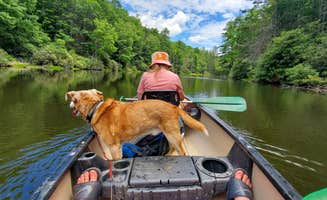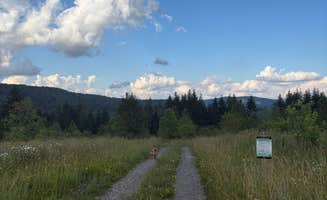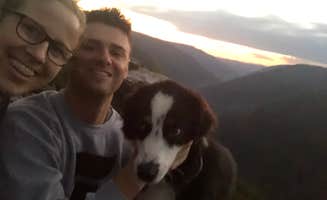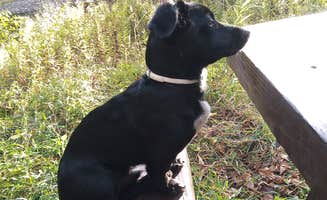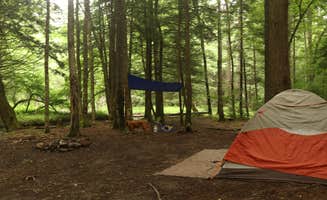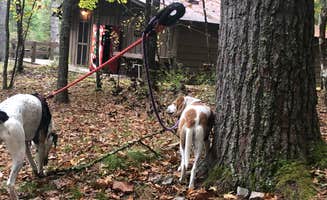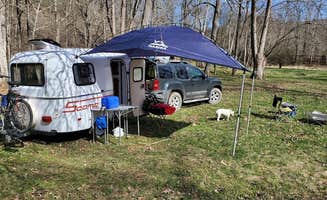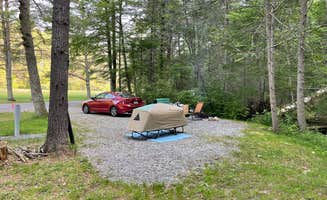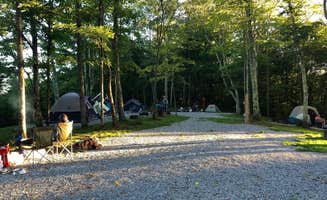Monongahela National Forest provides diverse dispersed camping opportunities near Cass, West Virginia, with elevations ranging from 2,000 to 4,000 feet throughout the region. The forest encompasses over 900,000 acres across the Allegheny Mountains with camping access varying significantly by season, as many forest roads close during winter months or after heavy rainfall.
What to do
Wildlife observation along waterways: Mower Basin offers excellent wildlife watching opportunities. "Following the road all the way to the final site you will cross paths with no fewer than 5 distinct and different toughness hiking trails, there are likely more, but I was only there for a week and would usually just do one trail a day," notes reviewer Mystic S.
Fire tower rental experience: Seneca State Forest features the historic Thorny Mountain Fire Tower. "Renting and staying in the Thorny Mountain Fire Tower is a special opportunity...the tower cabin structure has 360 views...11 windows and a windowed door...so you don't miss any of the show!" writes Dave V. The tower requires advance reservations and offers a unique overnight experience.
Fishing and paddling: Forest waterways support diverse fishing opportunities year-round. Near Seven Mile Campground, "you can fish Seneca Lake, toss your own paddlecraft in, or rent their boats. You can also swim at your own risk in the Greenbrier River," according to Dave V. Most waterways require West Virginia fishing licenses available online.
What campers like
Secluded river sites: The dispersed camping areas provide quiet riverside spots. "Little river has about 15 campsites along Little River Road. Most are decent, but a few are absolutely gorgeous. When you park and walk down to the river, if you turn right, there's a beach area about 50 yards down that offers a great spot to take a dip!" explains Tommy S. about Little River Dispersed Campsites.
Pioneer cabins: Rustic cabin options provide shelter while maintaining a wilderness feel. "We stayed in a cabin this time. One of the pioneer cabins. Let me say it was awesome, wood stove, gas light, outhouse and had to get your own water. The cabin was well put together and the staff has you set up to enjoy your stay with everything from soap to cut wood," shares David F. about his stay at Seneca State Forest.
Mountain views: Higher elevation sites offer expansive vistas not found in valley locations. "The moon was bright but you could still see hundreds of stars. There was a fire ring and enough space to fit a car and tent, but other sites were large enough to fit many cars and a dozen people," reports Jon N. about Mower Basin. Most mountain viewpoints can be reached via marked hiking trails.
What you should know
Bear awareness: Black bears inhabit the area, requiring proper food storage. "We kept all our food items and toiletries in a bear cannister during our trip. We did not experience any encounters or sightings, but fellow cyclists traveling in the same direction, observed a juvenile bear during the day along the trail," reports Dave V. about Greenbrier River Trail Milepost 63.8.
Road conditions: Many forest access roads require careful navigation. "About 7+ miles in from the town of Durbin on a dirt road (not sure how that would go in an RV but easy in a small vehicle). Beautiful dispersed camping near a creek in dense, lush forest," notes Erik C. about Little River Dispersed Campsites.
Cell service limitations: Expect minimal connectivity throughout the region. "Pocahontas County is home to the Green Bank National Radio Astronomy Observatory, a federal complex whose giant single-dish telescope detects 'invisible energy waves' from space. Within 10 miles of the Observatory, the use of cell phones, Wi-Fi, microwaves, and other devices is banned," explains Cindy B. about camping at East Fork Campground.
Tips for camping with families
Shallow water play areas: Several campgrounds offer safe water access for children. "We thoroughly enjoyed this campground. Very peaceful, surrounded by mountains. The campground had stables and catered to people with horses, but we felt very welcomed by the owners," writes Cindy B. about East Fork Campground, which provides river access suitable for families.
Wildlife education opportunities: The abundant forest wildlife creates natural learning experiences. "The amount of wildlife we saw throughout the day was incredible while biking the trail. Mostly deer, rabbit, chipmunks and Eastern Box Turtles sharing the trail...but we did see a few turkey, fox and bobcat," shares Dave V. about trails near Greenbrier River Trail Milepost 63.8.
Pet-friendly camping options: Nearly all dispersed sites welcome pets with standard leash requirements. "Jake from the Dyrt here! Snowshoe Valley camping is close to Snowshoe resort, and also surrounded by protected forests, perfect for getting some hiking in!" notes reviewer Jake C. about Snowshoe Valley Camping, a pet-friendly option near Cass.
Tips from RVers
Site size considerations: Many forest campgrounds have limited space for larger rigs. "The main campground roadway is fairly linear and quite narrow along a stream gradually ascending...likely termed a 'holler' to West Virginians. Sites 7 and 8 are beyond the turn for sites 9 and 10. Main campground roadway is new blacktop and smooth as silk," explains Dave V. about Seven Mile Campground.
Water access planning: Most dispersed sites lack hookups, requiring self-sufficiency. "Ten sites in all. Spaced out nicely, with 9 and 10 dog legged to the right from the covered well handpump (your source of water, other than filtering stream water)," notes Dave V. about Seven Mile Campground. RVers should arrive with full water tanks.
Weather preparation: Mountain weather can change rapidly, especially during summer storms. "In June, you can anticipate random, short afternoon or evening cloudbursts...but they can be gully-washers. Nights were cool and most mornings I wore a long-sleeve Merino shirt," advises Dave V. about conditions at Greenbrier River Trail Milepost 63.8.


